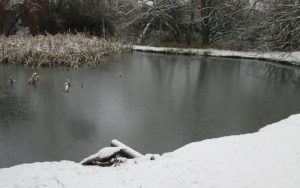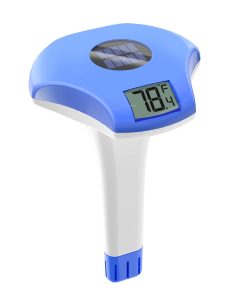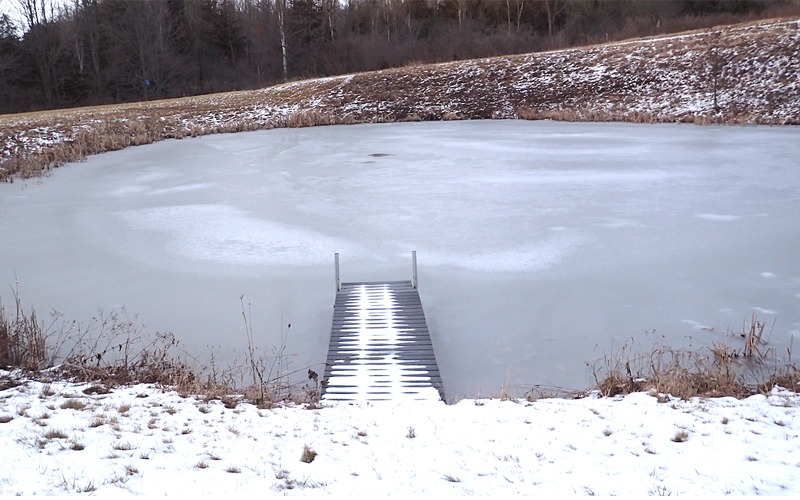How long does it take for a pond to freeze depends on a few things. Smaller ponds usually freeze faster than big ones because they’re not as large.
If you live in a really cold place, ponds freeze quicker than in warmer areas. The depth of the pond matters too – deeper ponds take more time to freeze.
Wind and water movement also play a role; they can speed up or slow down the freezing. Normally, ponds start freezing when the temperature goes below freezing (32°F or 0°C).
It’s hard to give an exact time, but several days of cold weather are usually needed for a pond to freeze solid. But be careful! The ice might not be the same everywhere, so it’s important to stay safe if you go to a frozen pond.
Today in this article we will describe how long for the pond to freeze. Here we will tell you how long it takes for a small, large, depth, and shallow pond to freeze. So without wasting more time let’s jump to the article.
Use This Pond Heater To Keep Your Pond From Freezing Over And Oxygen Exchange

How Long Does It Take For A Pond To Freeze In Winter

As we mentioned before how many days it takes a pond to freeze depends on lots of important factors like depth, size, and location. Here we will discuss all the factors. So let’s see depending on these factors what times does a pond take to freeze in winter?
Pond Size:
So, the most important thing about ponds and freezing in winter depends on the pond size. Suppose if a pond is small then it can freeze quicker than a large pond. So let’s see how many days it takes for different sizes of ponds to freeze in winter.
Small Ponds: Small ponds, with their limited water volume, can freeze relatively quickly. In cold climates, it might take just a few days of sub-zero temperatures for a small pond to develop a thin layer of ice.
Large Ponds: Larger ponds, due to their greater water mass, typically take longer to freeze. Even in cold weather, it may take weeks for a large pond to fully ice over.
Pond Depth:
Pond depth is another important factor. Because a shallow pond can freeze faster than a deep pond in winter. Anyway, first of all, let’s see how long does it takes for a shallow pond to freeze deep pond can?
Shallow Ponds: Shallow ponds freeze faster than deeper ones. The surface water in shallow ponds is more exposed to cold air, expediting the cooling process and leading to quicker freezing.
Deep Ponds: Deeper ponds, with their larger water volume, act as a natural insulator. It takes more time for the entire mass of water to reach the freezing point, resulting in a slower overall freezing process.
Location:
So the freezing of a pond totally depends on the location where the pond is situated. If the pond in a warm location then it won’t be freeze.
Cold Climates: Ponds in consistently cold climates tend to freeze more rapidly. In places where winter temperatures remain below freezing for extended periods, ponds can ice over quickly, especially during prolonged cold spells.
Warmer Regions: In warmer regions, ponds may take longer to freeze, and in some cases, may not freeze at all. Warmer temperatures slow down the cooling process, making it challenging for ice to form on the pond’s surface.
Hope it’s clear to you how long a pond takes to freeze. So, understanding these variations in freezing times based on pond size, depth, and location is essential for anticipating winter conditions and ensuring safety when exploring frozen pond surfaces.
Solar Pond Thermometer For Measuring Pond And Pool Water Temperature

How Long Does It Take For A Pond To Freeze For Skating
The time it takes for a pond to freeze sufficiently for skating depends on various factors. Generally, smaller ponds freeze more quickly than larger ones due to their reduced water volume.
Shallow ponds also freeze faster as the limited depth allows for quicker cooling. In colder climates, where temperatures consistently dip below freezing, ponds may freeze rapidly, facilitating early ice formation.
For safe skating, a pond typically needs several days of sustained cold weather, with temperatures consistently below freezing.
However, the thickness of the ice is crucial for safety. Skaters should wait until the ice is at least 4 inches thick for a single person and even thicker for larger groups.
Wind speed plays a role in the freezing process. Higher wind speeds can accelerate the cooling of the pond’s surface, expediting ice formation. Conversely, calm conditions may result in a more gradual freezing process.
Safety precautions are paramount when considering skating on frozen ponds. Ice thickness should be assessed carefully, and skaters must be aware of potential weak spots.
Regular monitoring of weather conditions is advised to ensure optimal skating conditions. Overall, while the allure of skating on a frozen pond is undeniable, responsible and informed decision-making is essential to ensure a safe and enjoyable experience.
Frequently Asked Questions
Q: What factors affect the time it takes for a pond to freeze?
A: Pond size, depth, location, ambient temperature, wind speed, and water movement impact freezing times. Small and shallow ponds in colder climates freeze faster, while larger, deeper ponds in warmer regions may take longer or remain unfrozen.
Q: Does the size of a pond influence how quickly it freezes?
A: Yes, pond size significantly affects freezing speed. Smaller ponds freeze more quickly due to their limited water volume, allowing for faster temperature reduction and heat loss compared to larger ponds.
Q: At what temperature does a pond typically start freezing?
A: A pond typically starts freezing when temperatures drop below 32°F (0°C), marking the freezing point of water. As the temperature descends, the water molecules lose heat energy, initiating the process of ice formation on the pond surface.
Q: Are there differences in freezing times for natural ponds versus man-made ponds?
A: Yes, freezing times differ. Natural ponds, influenced by diverse ecosystems and conditions, may freeze at varying rates. Man-made ponds, often in controlled environments, may freeze differently based on design, size, and surroundings.
Q: Can wind speed impact the freezing process of a pond?
A: Yes, wind speed can impact pond freezing. Higher wind speeds enhance heat exchange, causing faster cooling of the pond’s surface and expediting the freezing process during cold temperatures.
Q: How does the depth of a pond affect the time it takes to freeze?
A: Pond depth significantly influences freezing time. Shallow ponds freeze more quickly, with limited depth exposing water to rapid cooling. Deeper ponds, with greater volume, act as insulation, slowing the freezing process.
Final Words
So, the freezing time of a pond depends on factors like size, depth, and location. Smaller ponds freeze faster, shallow ponds freeze quicker than deep ones and colder climates lead to rapid freezing.
Pond freezing typically begins when temperatures drop below 32°F. Wind speed and water movement also play roles, influencing the cooling process.
Man-made ponds may freeze differently based on design. Understanding these factors is crucial for assessing safety and enjoying winter activities responsibly on frozen pond surfaces.





